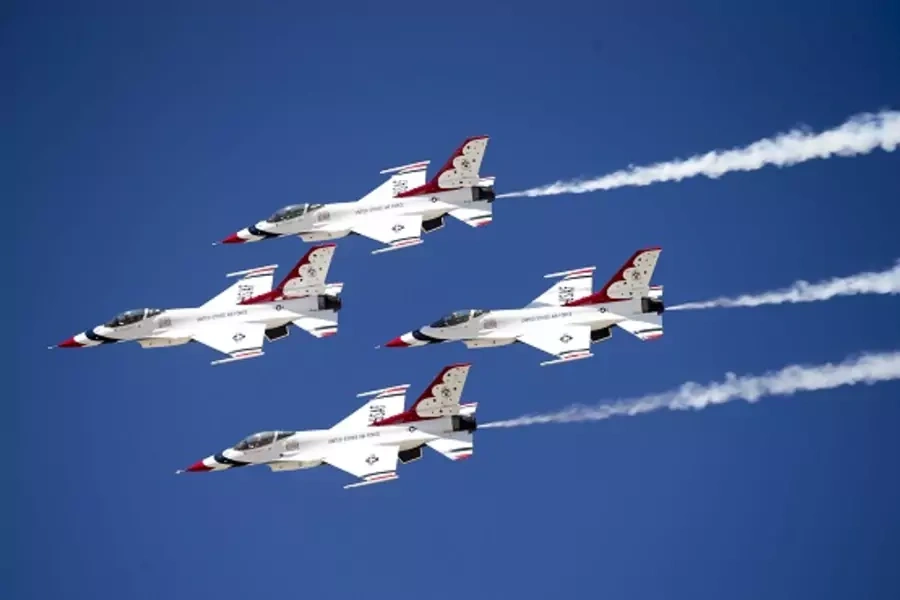Happy 69th Birthday to the U.S. Air Force!

The United States Air Force (USAF) turns sixty-nine years-old today. On September 18, 1947, Chief Justice Fred Vinson swore in Stuart Symington as the first secretary of the air force, officially founding a new branch of the U.S. military. Gen. Carl A. Spaatz became the USAF’s first chief of staff eight days later on September 26, 1947.
The origins of the USAF lie in a decision made just four years after the Wright Brothers conducted the world’s first airplane flight at Kitty Hawk, North Carolina. In 1907, the U.S. Army Signal Corps created an Aeronautical Division and put it in “charge of all matters pertaining to military ballooning, air machines and all kindred subjects.” As aviation technology improved, the army’s air force grew bigger. An independent military arm became virtually inevitable after the Army Air Forces became an autonomous U.S. Army Command in 1942 and then grew substantially throughout the remainder of World War II. On July 26, 1947, President Harry Truman signed the National Security Act of 1947 on board the presidential aircraft, the Sacred Cow, and set the creation of the USAF in motion.
More on:
I asked Col. Brian R. Bruckbauer, an air force officer spending a year as a visiting military fellow in CFR’s David Rockefeller Studies Program, to recommend some reading for people hoping to learn more about the air force. Here are Col. Bruckbauer’s great suggestions and commentary:
- Air Force Future Operating Concept (2015). In 2035, Air Force forces will leverage operational agility as a way to adapt swiftly to any situation or enemy action. Operational agility is the ability to rapidly generate—and shift among—multiple solutions for a given challenge, and forms a basis for examination, experimentation, and capability development planning for building the Air Force of the future.
- Laslie, Brian D. The Air Force Way of War (2015). Laslie examines the revolution in pilot instruction that Red Flag brought about after Vietnam. The program’s new instruction methods were dubbed “realistic,” preparing pilots for real-life situations better than the simple cockpit simulations. Laslie also analyzes how the graduates fared in combat during the 1980s and 1990s in Grenada, Panama, Libya, and Iraq.
- Olsen, John A. Air Commanders (2012). From Gen. Carl “Tooey” Spaatz, who began his career in World War I, to the recently retired Gen. T. Michael “Buzz” Moseley, Olsen’s case studies illuminate the character of these airmen, the challenges they confronted in widely disparate armed conflicts, and the solutions that they crafted and implemented.
- Hurley, Alfred F. Billy Mitchell: Crusader for Air Power (2006). Brig. Gen. William “Billy” Mitchell’s position as the dominant figure in American aviation from 1919 until his court-martial in 1925 has made him the frequent subject of biography and television, but usually the sensational elements have been overemphasized. Hurley portrays Mitchell as a man with a mission and a true pioneer of modern aviation, a man whose ideas about leadership in aerial operations inspire and instruct today’s airmen and women.
More on:
- Proietti, Matt. At All Costs (2015). On a remote radar outpost during the Vietnam War, a group of Airmen took on a mission shrouded in so much secrecy they had to officially leave the Air Force before reporting for duty. This team ensured bombs hit with precision deep inside enemy territory, and continued the mission until their post was compromised. The ensuing fight and his heroic actions would eventually earn Dick Etchberger the Medal of Honor.
- Trest, Warren A. Air Commando One: Heinie Aderholt and America’s Secret Air Wars (2000). Air-dropping agents behind enemy lines in clandestine missions during the Korean War, commanding secret flights into Tibet, participating in plans for the Bay of Pigs invasion; Brig. Gen. Harry C. “Heinie” Aderholt worked at the heart of the U.S. Air Force and CIA special operations. In 1964, he became commander of the famed First Air Commando Wing, and in 1966 and 1967, he and his men set the record for interdicting the flow of enemy trucks over the Ho Chi Minh Trail in Laos and North Vietnam.
If that’s not enough air force reading for you, you can learn more about the history of the USAF online through the Air Force Historical Support Division.
A tip of the TWE cap to all the men and women who have worn the uniform of the USAF.
 Online Store
Online Store